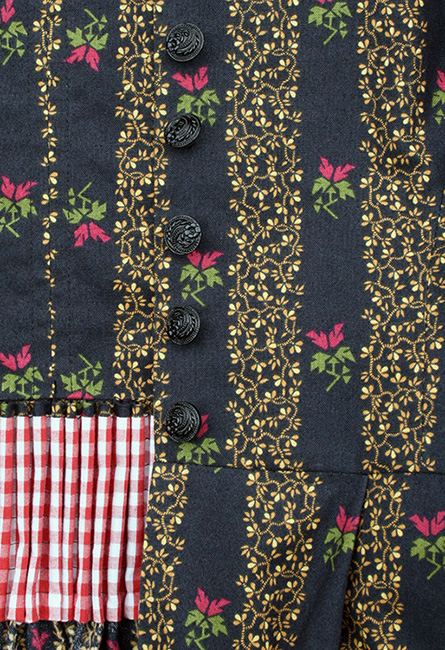
August – November 2020
A length of quilting cotton in the half-off fabrics caught my eye. It was clearly meant to be made into a folk costume! There’s just something about these floral motifs and tiny vines, plus the striped pattern.
The initial plan was to use Folkwear’s #123 pattern. Since my first dirndl was a princess seam bodice, this time around I wanted to try a darted pattern. A quick muslin, however, proved that the Folkwear bodice would require a lot of work. And I was in no mood for mock-ups. So instead I pulled out Butterick #5748 (which also has waist and bust darts), that was used for the 1960 dress. The Butterick neckline was reshaped in front, per Folkwear’s pattern, and the back was cut as a scoop. Originally, #5748 had been given a 1/4″ full bust adjustment (FBA). However, my dirndl ended up with some excess fabric around the bust. This is the price one pays for skipping the mock up! It’s likely I should have removed the FBA. Still, a closer view of the bodice shows that in this busy, dark print it’s not much of an issue. If you’d like to know any more about the construction of dress and apron, please see my writeup for the red dirndl. This one lacks boning, but otherwise they are the same.
The plum apron has a tiny print. It’s not even discernible in these photos. The seller offered this fabric by the yard only, which isn’t quite enough, but I had lots of extra black fabric for the straps. In fact, the bodice is self-lined in the black as well. Two layers of quilting cotton makes for a very sturdy bodice. Beautiful black glass buttons, purchased at Poppy Fabric in 2007, were finally put to use for the center front closure. And luckily I had an extra! One button was chipped along the shank. I didn’t even notice this until the button managed to free itself from the bodice – by cutting through the 6-8 threads holding it.


The image above, on the left, shows the dirndl unbuttoned. To the right is the outside of the bodice. There are glass buttons, a single waist dart barely visible in a stripe of vines, and skirt pleating at center front. To the left, the dirndl’s self-fabric lining is visible. The center back lining seam runs along stripe of vines and is topstitched flat. The skirt is cartridge pleated using the Hansl fabric as a guide.
I wanted something a little more sophisticated than either of my poof-sleeved dirndl blouses. And none of the white blouses in my costume closet were quite right. So I ordered this absolutely lovely 100% cotton batiste blouse from Novica. The details and quality exceeded my expectations. The long white socks are striped and lacy (from Sock Dreams), and the shoes were thrifted a while back. I thought they’d make excellent dirndl footwear. And one does not pass up a well-fitting pair of black patent Mary Janes.


